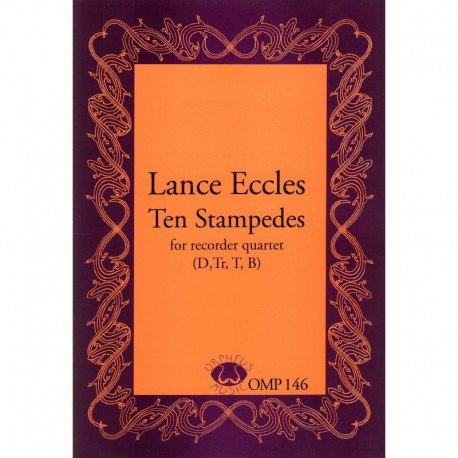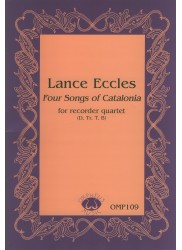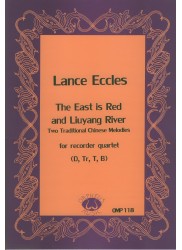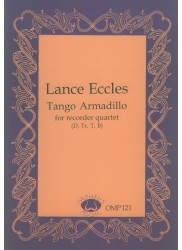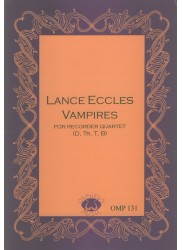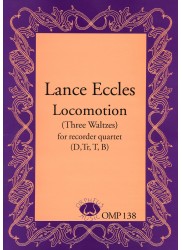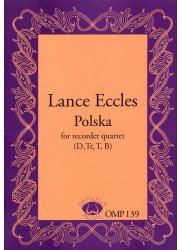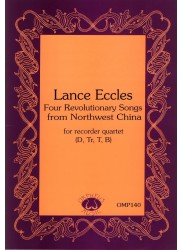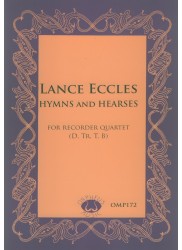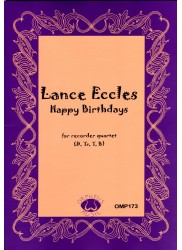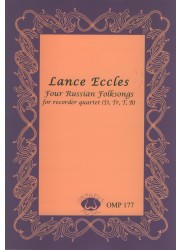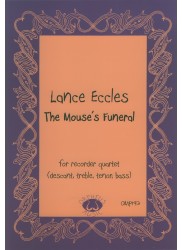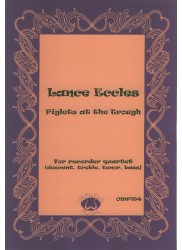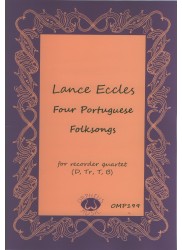No products
Prices are tax included
Ten Stampedes
Composer: Eccles - Lance
Instrumentation: Descant - Treble - Tenor - Bass
Period/genre: Australian Contemporary
Grade: Moderate - Difficult
More info
*Contemporary Pieces.* Lively and fun series of character pieces with some nice rhythmic twists.
1. Stampede of Rabbits
2. Stampede of Warthogs
3. Stampede of Angels
4. Stampede of Tranatulas
5. Stampede of Hippopotamuses
6. Stampede of Jellyfish
7. Stampede of Holy Monks and Incubi
8. Stampede of Happy Shepherdesses
9. Stampede of Snails
10. Stampede of Termites
_Score 23 pp. Parts 10 pp._
REVIEWS OF TEN COMPOSITIONS BY LANCE ECCLES
(Orpheus Music, orpheusmusic.com.au).
For 20 years, Lance Eccles was a member of the Reluctant Consort, a group based in Sydney, Australia. Most of his compositions have been written for this consort or for meetings of the Sydney Society of Recorder Players. Eccles is retired from his position as a senior lecturer in Chinese at Macquarie University. His current web site states that he is an "honorary senior research fellow in the Department of Ancient History at Macquaie University in Sydney, Australia"; see www.ocs.mq.edu.au/~leccles.
There are generalities that apply to many of the pieces reviewed here. The reader will note that all of the pieces have colorful programmatic titles. Sometimes, the music des indeed match the literary ideas of the titles. In this reviewer's opinion, there are other cases (as specifically noted below) where the literary images of the title and the actual music do not seem to connect. It may be, in some cases, that some words in these titles simply have other connotations in Australian culture. In any case, a simple solution for this problem would be for the publications to include information regarding the literary ideas behind the titles and how these ideas connect to the music.
Concerning his style, rhythms are straightforward and on the easier side, oftentimes using light syncopation. For the most part, the voices are very active, with a common exception being the bass lines. It is rare for the upper voices to hold any note longer than a halfnote, sometimes even in the final measures. Eccles has a remarkable ability to have voices moving every half beat for extended passages. He does a great job keeping his voices in lively contrary motion, but he also uses parallel motion to great effect. He likes abrupt endings.
Some of his music uses lush Romantic harmonies; some is more contemporary and mildly dissonant or even sharply dissonant. Eccles is equally at home in all these harmonic idioms. To enjoy hearing and playing Eccles's music, you will need a taste for contemporary harmony. Having said that the rhythms are easy, I should also mention that most of his music is quite chromatic. If your groups are interested in playing these pieces, get out the chromatic scales; you will need to know all chromatic fingerings.
Eccles likes to use phrase modulations to distantly-related keys. There are no avantgarde techniques in any of these pieces, beyond simple flutter-tonguing. If I had to rate them for difficulty on a scale of one to five, most would rate a three with exceptions noted below.
Regarding prices listed, Orpheus Music will remove taxes from the total for non- Australian customers. Prices vary day to day. These pieces are listed with two purchase options: the published version (in hard copy with the well-known purple and orange covers) and the .pdf instantly-downloadable version from orpheusmusic.com.au.
OMP146 Lance Eccles Ten Stampedes
This suite of 10 character pieces has me indeed perplexed about how the literary ideas behind the titles relate to the music. When I think of the most commonly used definition of "stampede," negative images of destruction come to mind. Stampedes reflected in music would have a sense that something is wrong, then the sense of panic, and a chaotic rush to safety. The end result of a stampede is usually tragic.
However, the negative connotations of "stampede" are not reflected in this music. Thus, I would have to assume that the use of the word "stampede" refers to one of the word's lesser-used definitions - perhaps a celebration. Since this word's etymology includes the Spanish word estampida, I must conclude (from the nature of the music) that this publication is a set of celebratory dances. This is one instance where more programmatic information would help.
In the first piece, "Stampede of Rabbits," the performance instruction says "leaping," and that's exactly what most of the parts do most of the time. There is a middle section where the melody becomes stepwise and is passed between the soprano and alto recorders. Some leaps are augmented octaves, creating striking leaps into dissonance. Near the end, Eccles uses sequences in descending-fifths with seventh chords, emphasizing more dissonances.
"Stampede of Warthogs" consists of mostly lighthearted tonal harmony with a cute melody and interesting syncopations against this melody. Phrase modulations to distantly related keys give this piece a more contemporary slant. Within 34 measures, the key signature moves from G minor to B minor to D minor, and back to G minor. The very easy bass line in this piece is appropriate for less experienced bass players.
The third selection, "Stampede of Angels," has the performance direction, "soaring." When played slowly, this is a lovely, ethereal piece in 3/4 time. Sometimes it uses traditional common practice harmonies, and at other times sudden 4/4 measures of accented dissonance. What thoughts are behind the use of this means of interruption?
Adding to the otherworldly atmosphere of the piece are other harmonic intricacies - unresolved seventh chords, parallel tritones between adjacent voices, and a cross-relation between B and B in the penultimate measure. A surprise final cadence, in A Major rather than C Major, produces quite a nice ending!
"Stampede of Tarantulas" is a march - fun to play, especially the bass part. This fourth piece is not particularly dissonant, but it does have the Eccles signature phrase modulations to distantly- related keys (i.e., A minor to F minor). The thought of tarantulas is alarming to most of us arachnaphobes, yet I don't really hear a sense of frightful drama in the music. Augmented seconds in the melody gives the march just a touch of a more eerie character.
The music in "Stampede of Hippopotamuses" does match its title, at least in the idea of hippos tromping around. The bass line stomps away at a steady stream of eighth-note fifths or octaves. The other parts are in constant motion, most of it contrary to the bass line.
As often happens in Eccles's music, this piece does not return to its starting key; it begins in G Major, but ends suddenly and unexpectedly on an F Major chord. There are skips into dissonances between the soprano and alto parts. In one striking spot, an E Major chord moves up (in parallel octaves and fifths) to an E Major chord!
The sixth piece, entitled "Stampede of Jellyfish," is a very impressionistic movement featuring many Medievalsounding rising or falling parallel fifths and octaves. The performance instruction says: "not slow"; I have to admit, having tried various tempos, that weliked it better on the slow side. The bass line is left out of most of the interesting material and functions solely as harmonic support.
"Stampede of Holy Monks and Incubi" is "swinging but not fast." It consists of a gently syncopated melody with lots of pedal point in the bass line. In fact, just out of curiosity, we played this piece with only the soprano and bass lines, which made a lovely, haunting duet. The bass line of this piece is very repetitive - for 23 out of 54 measures, the bass has only the note G. But with a willing bass player, the upper parts combine into quite a nice piece.
The eighth, "Stampede of the Happy Shepherdesses," is easy to play - a simple, non-dissonant, waltz-like piece. But within its simplicity and traditional sounding harmony, it still does not return to the home key; it starts in C Major and ends in G Major.
"Stampede of the Snails" gently glides up and down the chromatic scale in eighth-notes over a rich, contemporary harmony. The bass again is mostly harmonic support, but does contain four measures of arpeggios in contrary motion with the melody. Even in slow movements, Eccles can be counted on to have at least one voice in constant motion; syncopations in the inner voices add to the harmonic interest.
The tenth piece in this suite, "Stampede of the Termites," once again requires a bass player who doesn't mind providing only harmonic support. The soprano and alto engage in interesting repartee at the beginning, and later the tenor joins the conversation, but this piece is too repetitive for my tastes. Perhaps this represents the repetitiveness of termites' destructive activities.
While individual pieces in this suite sometimes do not return to the piece's initial key, the suite taken as a whole does; it begins and ends on a C Major chord. The harmonic excursions within each piece are complex enough to keep a music theory student busy at analysis!
Susan Groskreutz, American Recorder, January 2011.
30 other products in the same category:
Reference: OMP109
Brand: Orpheus Music
Four Songs of Catalonia
Composer: Eccles - Lance Instrumentation: Descant - Treble - Tenor - Bass...
In StockReference: OMP109.pdf
Brand: Orpheus Music
Four Songs of Catalonia
PLEASE NOTE - DOWNLOADABLE PDF VERSION Composer: Eccles - Lance...
$22.00 -20%In StockReference: OMP118
Brand: Orpheus Music
The East is Red and Liuyang River
Composer: Eccles - LanceInstrumentation: Descant - Treble - Tenor -...
In StockReference: OMP118.pdf
Brand: Orpheus Music
The East is Red and Liuyang River
PLEASE NOTE - DOWNLOADABLE PDF VERSION Composer: Eccles -...
$17.50 -20%In StockReference: OMP121
Brand: Orpheus Music
Tango Armadillo
Composer: Eccles - LanceInstrumentation: Descant - Treble - Tenor -...
In StockReference: OMP121.pdf
Brand: Orpheus Music
Tango Armadillo
PLEASE NOTE - DOWNLOADABLE PDF VERSION Composer: Eccles -...
$16.00 -20%In StockReference: OMP129
Brand: Orpheus Music
Ruins
Composer: Eccles - LanceInstrumentation: Descant - Treble - Tenor -...
In StockReference: OMP129.pdf
Brand: Orpheus Music
Ruins
PLEASE NOTE - DOWNLOADABLE PDF VERSION Composer: Eccles -...
$22.00 -20%In StockReference: OMP130
Brand: Orpheus Music
Avarice
Composer: Eccles - LanceInstrumentation: Descant - Treble - Tenor -...
In StockReference: OMP130.pdf
Brand: Orpheus Music
Avarice
PLEASE NOTE - DOWNLOADABLE PDF VERSION Composer: Eccles -...
$20.50 -20%In StockReference: OMP131
Brand: Orpheus Music
Vampires
Composer: Eccles - LanceInstrumentation: Descant - Treble - Tenor -...
In StockReference: OMP131.pdf
Brand: Orpheus Music
Vampires
PLEASE NOTE - DOWNLOADABLE PDF VERSION Composer: Eccles -...
$20.50 -20%In StockReference: OMP138
Brand: Orpheus Music
Locomotion
Composer: Eccles - LanceInstrumentation: Descant - Treble - Tenor -...
In StockReference: OMP138.pdf
Brand: Orpheus Music
Locomotion
PLEASE NOTE - DOWNLOADABLE PDF VERSION Composer: Eccles -...
$20.50 -20%In StockReference: OMP139
Brand: Orpheus Music
Polska
Composer: Eccles - LanceInstrumentation: Descant - Treble - Tenor -...
In StockReference: OMP139.pdf
Brand: Orpheus Music
Polska
PLEASE NOTE - DOWNLOADABLE PDF VERSION Composer: Eccles -...
$20.50 -20%In StockReference: OMP140
Brand: Orpheus Music
Four Revolutionary Songs from North West China
Composer: Eccles - LanceInstrumentation: Descant - Treble - Tenor -...
In StockReference: OMP146.pdf
Brand: Orpheus Music
Ten Stampedes
PLEASE NOTE - DOWNLOADABLE PDF VERSION Composer: Eccles -...
$36.00 -20%In StockReference: OMP172
Brand: Orpheus Music
Hymns and Hearses
Composer: Eccles - LanceInstrumentation: Descant - Treble - Tenor -...
In StockReference: OMP172.pdf
Brand: Orpheus Music
Hymns and Hearses
PLEASE NOTE - DOWNLOADABLE PDF VERSION Composer: Eccles -...
$28.00 -20%In StockReference: OMP173
Brand: Orpheus Music
Happy Birthdays
Composer: Eccles - LanceInstrumentation: Descant - Treble - Tenor -...
In StockReference: OMP173.pdf
Brand: Orpheus Music
Happy Birthdays
PLEASE NOTE - DOWNLOADABLE PDF VERSION Composer: Eccles -...
$20.50 -20%In StockReference: OMP177
Brand: Orpheus Music
Four Russian Folksongs
Composer: Eccles - LanceInstrumentation: Descant - Treble - Tenor -...
In StockReference: OMP177.pdf
Brand: Orpheus Music
Four Russian Folksongs
PLEASE NOTE - DOWNLOADABLE PDF VERSION Composer: Eccles - Lance...
$20.50 -20%In StockReference: OMP193
Brand: Orpheus Music
The Mouse's Funeral
Composer: Eccles - LanceInstrumentation: Descant - Treble - Tenor -...
In StockReference: OMP193.pdf
Brand: Orpheus Music
The Mouse's Funeral
PLEASE NOTE - DOWNLOADABLE PDF VERSION Composer: Eccles -...
$20.50 -20%In StockReference: OMP194
Brand: Orpheus Music
Piglets at the Trough
Composer: Eccles - LanceInstrumentation: Descant - Treble - Tenor -...
In StockReference: OMP194.pdf
Brand: Orpheus Music
Piglets at the Trough
PLEASE NOTE - DOWNLOADABLE PDF VERSION Composer: Eccles -...
$20.50 -20%In StockReference: OMP199
Brand: Orpheus Music
Four Portuguese Folksongs
Composer: Eccles - LanceArranger: Lance EcclesInstrumentation: Descant -...
In StockReference: OMP199.pdf
Brand: Orpheus Music
Four Portuguese Folksongs
PLEASE NOTE - DOWNLOADABLE PDF VERSION Composer: Eccles - LanceArranger:...
$22.00 -20%In Stock

